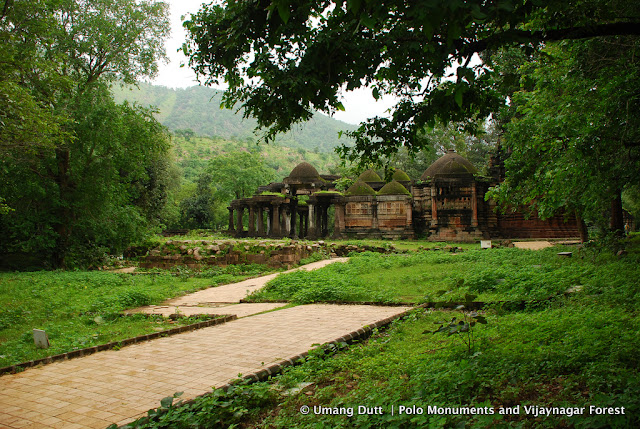I had been planning to go to Polo and Vijaynagar Forests for a very long time. Images of long lost civilizations, ancient temples playing hide and seek in the mist and the lush green forests played on my mind as i tried to figure out the best way to get there...
Finally D-day arrived and on 22nd August at 08:00 we (my parents, wife, 2 kids and 2 dogs, thanks to the Safari) set off in search of the mysterious ruins of the Polo kingdom. We managed to cover the 160 odd Kms. in a little over 2 hours. I could not find details about where exactly the ruins were located and so it took a little time to find the place.
Actually the ruins of the temple are spread across 4-5 sites all within 10 kilometres of each other. The archeologically important Shiv Temple at Sarneshwar, Sadevant Savlings Deras, Surya Mandir, Lakhena Temple, Jain derasar and the ancient Polo Jain Nagri are worth visitng.
After the town of Idar, one needs to take the road towards Khedbhrama and then keep a look out for a turn on the right which says Vijaynagar 45 Kms. The 1st of the sites is around 30 Kms. down the road and there are some signboards put up by the archaeological department, but you need to keep a look out for them. You can also ask the locals for the "Dam site" or Vanaj and they will point you in the right direction.
 |
| Shiv-ling |
 |
| Carvings on Shiv Temple |
The ancient Polo city was built around the river Harnav, an ancient water body spoken of in the Puranas. It is believed to have been established in the 10th century by the Parihar kings of Idar, and was then conquered in the 15th century by the Rathod Rajputs of Marwar. The name is derived from pol, the Marwari word for "gate," signifying its status as a gateway between Gujarat and Rajasthan. It was built between Kalaliyo in the east, the highest peak in the area, and Mamrehchi in the west, considered sacred by the local adivasis. Together they block sunlight for most of the day, which might provide an explanation for the otherwise mysterious abandonment of the ancient city.
 |
| Walking across the bridge with water flowing over it |
Now for some clarifications, the dam is actually a small check-dam built across the Harnav River, which is actually a small perennial stream. There is a small bridge which takes you from the main road to the other side where there is a nice forest. This bridge was actually the highlight of the trip for the kids. They had a great time walking through the water that was flowing over the bridge towards the check dam. A few hundred meters and quite suddenly the ruins of the ancient temple come into the view.
 |
| Lord Krishna |
 |
| More intricate work |
 |
| Lord Ganesh in the centre |
 |
| Door carving |
The 2 Jain temples and a Shiva temple are said to have been built sometime in the 15th century. There is not much left of them and honestly there does not seem as if much of an effort has been made to conserve the little that remains of these temples. It was quite interesting the see carvings of Lord Ganesh, Lord Krishna, Hanuman and other Hindu Gods on these temples. I bet the carvings of dragons on the temple walls also had an interesting story to tell. It was a pity that there was no one there to explain all this to the visitors / tourists who came there.
 |
| Jain temple |
 |
| Jain Temple |
After spending around an hour and half at the site, we visited another temple which was supposed to be restored (found the reference on the web). This was a much smaller Shiva temple and though not restored (at least it did not look much better than the others) there was a idol inside the temple and it was obvious that prayers were being offered regularly there.This one was built sometime in the 10 century and was supposed to be the oldest temple in the area.
 |
| Shiv Temple |
 |
| Shiv-ling and the snake God |
The extremely humid climate made us call it a day and we started our journey back to Ahmedabad, stopping on the way for some lovely tea and some really juicy boiled maize (makai).
I actually fell in love with the place and promised to return once again to take more pics, only this time I would make sure to go there in December when the weather was much more conducive to trekking.
Best time to visit: November to January
Note: Don’t forget to carry some water and eatables ‘cause there is not much available after Idar.
Don't forget to check out all the pics from Polo and Vijaynagar here
 |
| Polo Monuments and Vijaynagar Forest |




9 comments:
Cool
I like the way you have described the journey and definately photos
Shailendra Singh Negi
Umang ,very well described and i guess you had a wonderful time ther at polo.thnks for sharing thisplz also chek this at ur convenience
http://www.facebook.com/photo.php?fbid=1143120651635&set=a.1200740532096.2031943.1036034151&type=1&theater
ther are many sketches i made at polo .u can chek it at ur convenience on fb.
Thanks Shailendra and Tejas
Brilliant post Umang..felt myself being there..
Thanks Kartikey. I am glad you liked it :)
Thanks for sharing a wonderful place.
Great pictures.
- Prakash KJ
Nice place ..Think to go there...
can u suggest some thing?
Cool photos! How it looked in summer: here
I don’t know how should I give you thanks! I am totally stunned by your article. You saved my time. Thanks a million for sharing this article.
Post a Comment